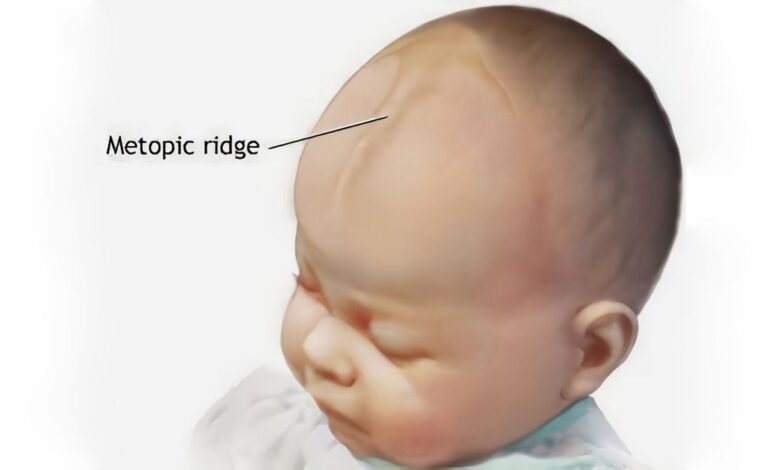Metopic crest in a child and an adult: What's it, causes, symptoms, diagnostics, treatment, prevention

Metopic ridge
Metopic crest: What it is?
Metopic crest – this is an anomaly of tissue fusion on the forehead and head in infants. This rare congenital condition is characterized by the presence of vertical folds of skin and prominent bones on the forehead..
Metopic ridge should be distinguished from metopic synostosis, which is a more serious condition.
Causes of the metopic ridge
A metopic ridge usually results from a misalignment of the skull bones in the plane between the frontal bones.. This may be caused by genetic factors or environmental influences on the fetus.. Some of the possible causes of a metopic ridge may include:
- genetic mutations: Some rare genetic mutations may be associated with the development of the metopic ridge.
- Surgical intervention: Early surgical interventions on the infant's head or face can interfere with normal skull fusion and lead to the development of a metopic crest..
- Environmental impact: Some environmental factors, such as adverse pregnancy conditions or drug exposure in the early stages of development, may affect the formation of the infant's skull.
Metopic ridge symptoms
The main symptom of a metopic ridge is the presence of vertical folds of skin on the forehead and protruding bone formations.. Possible symptoms of a metopic ridge may include:
- Protruding or angular bones on the forehead;
- Vertical folds of skin on the forehead;
- Unusual shape of the skull or face;
- Maybe, disruption of the growth or formation of the skull and facial bones.
When to see a doctor
If your baby has signs of a metopic ridge, it is important to see a doctor for evaluation and advice. The following cases may require immediate medical attention:
- Rapid and significant changes in the size or shape of the ridge;
- Difficulties in breathing, feeding or other problems, associated with the metopic crest;
- The appearance of other symptoms, such as impaired development or poor growth.
Questions, which the doctor may ask
When contacting a doctor with a metopic comb, the doctor may ask you some questions, to better understand your condition and your baby's medical history. Some of the possible questions might include:
- When did you notice changes in your baby's forehead??
- Have you had a history of congenital anomalies or genetic diseases in the family?
- Have you had problems with pregnancy or childbirth??
- Whether surgery has been performed on the baby's head or face?
- What other symptoms is your baby experiencing??
Answering these questions will help your doctor better understand your condition and determine the appropriate plan for further examination and treatment..
Metopic ridge diagnosis
Diagnosis of a metopic ridge begins with a doctor's examination and medical history.. The physician may recommend some additional testing to confirm the diagnosis and evaluate the extent and impact of the metopic ridge. This can be:
- Echocardiogram: This is a special radiographic study, which can help visualize the structure of the head and skull.
- CT scan (CT) or magnetic resonance imaging (MRT): These imaging modalities can be used to examine the skull in more detail and evaluate the structure and bones of the face..
- Genetic tests: If genetic factors are suspected, a doctor may recommend genetic tests to evaluate for mutations or abnormalities.
Metopic ridge treatment
Treatment of a metopic ridge depends on the severity of the condition and the individual situation of the patient.. Your doctor may recommend the following approaches:
- Waiting and watching: When, if the metopic ridge does not cause problems and does not affect the development of the infant, an expectant approach with regular follow-up may be recommended.
- Surgical intervention: In some cases, especially with significant problems in the development of the face or bone structures, surgery may be required to correct the metopic ridge.
No treatment or surgery is required for a metopic ridge, if this is the only anomaly of the skull.
Home Treatment
Metopic ridge treatment cannot be done at home. Seeing a doctor and following his recommendations is an important part of the process of treating and caring for a child's health..
Metopic ridge prevention
There are no methods to prevent metopic ridge, since most cases of metopic ridge are accidental and not preventable. But, You may find the following tips helpful:
- Healthy lifestyle: Take care of your health during pregnancy, following healthy eating guidelines, regular physical activity and avoiding bad habits.
- Regular doctor visits: Regular visits to the doctor during pregnancy can help track down any developmental abnormalities and ensure optimal care for the baby..
- Follow your doctor's recommendations: Follow your doctor's recommendations for pregnancy management, take prescribed vitamins and medications, and follow the instructions for a safe and healthy pregnancy.
Remember, that consultation with a doctor is the most reliable source of information and advice for your particular case.
Used sources and literature
Craniosynostosis and Positional Plagiocephaly Support (CAPPS) website. The metopic ridge / benign or surgical? www.cappskids.org/metopic-ridge/. Accessed January 28, 2022.
Gerety PA, Taylor JA, Bartlett SP. Nonsyndromic craniosynostosis. In: Rodriguez ED, Losee IS, Neligan PC, eds. Plastic Surgery: Volume 3: Craniofacial, Head and Neck Surgery and Pediatric Plastic Surgery. 4th ed. Philadelphia, PA: Elsevier; 2018:chap 32.
Jha RT, Magge SN, Keating RF. Diagnosis and surgical options for craniosynostosis. In: elbow RG, Sekhar LN, Kitchen ND, da Silva HB, eds. Principles of Neurological Surgery. 4th ed. Philadelphia, PA: Elsevier; 2018:chap 9.
Kinsman SL, Johnston MV. Congenital anomalies of the central nervous system. In: Kliegman RM, St. Geme JW, Bloom NJ, Shah SS, Tasker RC, Wilson KM, eds. Nelson Textbook of Pediatrics. 21st ed. Philadelphia, PA: Elsevier; 2020:chap 609.
